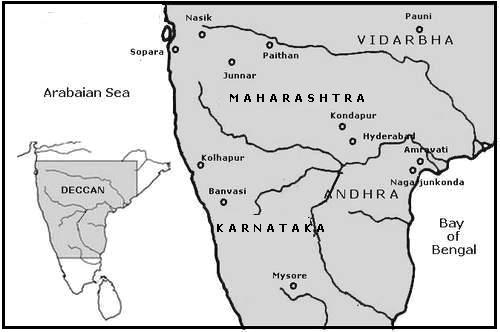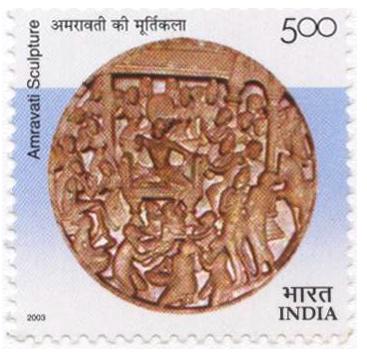|
Coins of Postmauryan Deccan

Map of Postmauryan Deccan ( 1st Century BC - 3rd
Century AD )
With collapse of Mauryan power soon after Asoka in
second century BC the local administrative officers , who were called Maharathis
, Mahatalavara and Mahasenapati built up their own kingdoms and began to issue
their own coins . Some of the uninscribed coins might belong to them . But they
soon issued coins inscribed with their names . The Maharathis may be looked upon
as the earliest known rulers of the deccan . They were succeed by Kura , Ananda
,Hasti , Mahatalavara , Sada , Sebaka families in deccan . The Vidarbha was
ruled by Mitra and Bhadra Rulers which were suceeded by Satavahanas . After
Satavahanas Ishvaku ruled the Andhra region .For the first time we find that
lead was used for coins . Later it become prime metal of deccan for a long time
and from there it went to Gujrat and Malwa and then to Punjab where it was first
used by Strato II, the Indo-Bactrian Ruler and S'aka Kshatrapa Rajuvula who
issed some coins in this metal .
Kuras
of Kolhapur : In Maharashtra
region around Kolhapur rose one of Maharathi family whose progenitor
was Maharathi Kura . His coins bear the legend Maharathisa Kurasa . He was
succeeded by Vilivayakura , who at first retained the title of Maharathi and
issued coins with inscription Maharathisa Vilivayakurasa and then adopted title
Rajno ( Raja or King) and metronymic title . This is the earliest metronymic
inscription on indian coins . Sivalakura , who was successor of Vilivayakura
issued coins in lead and introduced copper or potin also . These coins uniformly
bear bear a bow and arrow along with inscription on obverse and arched
hill either or alone with tree in railing . An interesting feature of Kura coins
is that they are mostly re-struck for example the coins of Vasisthiputra
Vilivayakura are re-struck with dies of the coins of Madhariputra Sivalakura . A
number of Kura coins have been found amongst the coins of Bramhapuri hoard , Cut
into half , one third and a quarter . ( I have shown one coin from my collection
) Perhaps they were cut to serve the purpose of fractional coins .
Maharathi Rulers of Belgaum :
There is another dynasty retaining title Maharathi
existed in the area of Belgaum . The Known coins are of lead with an elephant on
one side and a tree on the other . Above the inscription is the legends
Maharathisa Siva Kshapanasa . Some other dynasty or dynasties , retaining the
title Maharathi existed in Andhra region , but the inscriptions on their coins
are so fragmentary that nothing can be made out of their issuers . If Siva
Kshapanasa was a personal or dynastic name cannot be said. In between
inscription and elephant are three symbols , variously placed on different coins
.
Ananda Rulers of Banwasi :
The Ananda family existed in the Karwar region .
Chutukulananda, Mulananda and Shivananda are the only members of the family who
are known from their lead coins . There lead coins have a big nine arched hill
and over this hill there is inscription . The reverse has a tree in railing with
few small symbols . they are the earliest Deccan rulers who had adopted the
title Raja( Rajno) on their coins . Their coins are known from Karwar area and
excavations at Chandravalli , and some other places in Banvasi region . Most
likely these rulers had came after the Sadakana rulers .

Amravati Sculpture : 2003
Mitra and Bhadra Rulers of Vidarbha :
Before Satavahanas the Vidarbha region was ruled
by group of rulers having suffix Bhadra and Mitra . The early coins of are of
punch marked type and rest are produced by die-struck technique . This dynasty
was brought in light by some eminent scholars like Mr S. Bhandare , Mr Gupta ,
Mr Shastri , Mr Kulkarni , Mr Amiteshvar Jha . The rulers of this dynasty are
Damabhadra , Satyabhadra-I , Dharmabhadra , Sarvabhadra , Satyabhadra-II ,
Kanhamitra , Suryamitra . The coins of Suryamitra were overstruck by the
Satavahana Ruler Satakarni-I . The overstrucking consists of jjain symbol with
crecent at one orb and legends Rano Siri Satakanisa . The Gajalakshmi type
uninscribed coins were issued by Satyabhadra-II . These coins are available in
different denominations ranging from 1.00 to 6.00 Grams . These have Lakshmi
standing on a lotus with elephants standing on lotus on either sides annointing
her with pious water from their raised trunk .
Satavahana Dynasty : The Satavahana
dominated the political scene of the deccan after decline of the Mauryas . They
came as most powerful rulers of deccan and defeated the other kingdoms such as
Mitra and Bhadra , Sebaka Rulers as it can be seen from the coins of these
rulers over struck by the Satavahanas . The coins of Satavahanas are mostly
found in Andhra , Karnataka , Maharashtra , Madhya Pradesh , Gujrat and some
part of Tamilnadu . These coins are richest in deccan numismatics both in
variety and quantity . They issued coins Silver , Copper , Potin , Lead . Also
some of the coins follow the pattern issued by the predecessors of certain
region ( eg . Junnar region ) . Their are many varieties still waiting for their
proper attribution and there is virgin territory for research . Generally the
Satavahana coins have bramhi legends giving names of kings in prakrit
and in most of cases they have Ujjain symbol with crecent at one orb on
reverse which testifies their dynasty . In Maharashtra and Vidarbha , a large
number of copper or potin coins are found . showing an elephant with the trunk
upraised or hanging down on obverse and Ujjain symbol with crecent at one orb on
reverse . There are many rulers of the dynasty Six of them viz. Siri Satkarni ,
Siri Pulumavi , Sivasiri Pulumavi , Skanda Satkarni , Siri Yajna Satakarni ,
Vijaya Satakarni of the puranic list and four other rulers viz . Saka Satakarni
, Rudra Satakarni , Kumbha Satakarni , Karna or Krishna Satakarni which are not
mentioned in puranic list .
Ishvaku Dynasty :
The Successors of Satavahanas such as Ishvakus
imitated the Satavahana pattern in their coinage . their coins hane been
mostly found in Karnataka and Andhra area . After Satavahanas the Pallavas ruled
in the southern and the Ishvakus in the northern part of the region with capital
at Nagarjunakonda . They imitated the potin coins of Satavahanas , having
elephant on one side and the ujjain symbol on other . These coins are somewhat
crude and cannot be attributed to any particular ruler . Some of them are having
the names of Rulers such as Chantamula , Shantamula and Virapurushadatta .
Note : There are other issues like Western Kshatrapas
which are not discussed here due lack of space.

Gadhaiya Coins from Madhya Pradesh
Om / Omkar type Gadhaiya Coins
:
There is one coin reported from Madhya pradesh bears legends " Shri Om " or " Omkara " . Some scholars had attributed Paramara Rulers as issuer of coin . this coin is from post gupta period . These coins are of copper or billon commonly known as " Gadhiya " Coins .
The coin is based on Sassanian pattern and the obverse side of coin bears Head or Bust of King ( Granulated ) and reverse side bears the legends " Shri Om" or " Omkara " . It is believed that these coins were issued in the name of Omkara Mandhata , whose famous temple stands on the banks of Narmada at Mandhata , not far from Indore .

Coins of Gurjara - Pratihara Rulers
Gurjara - Pratihara Coins
:
Nagabhatta I founded the
dynasty of Pratihara in the
beginning of eighth century A.D.
There is controversy with regard to origin and place of origin of the Pratiharas
. Some scholars are in view that Pratiharas are of Gurjara Clan ( In Chinese Kiu
- Cha = Gurja) . These were foreigners and they came to India along with White
hunas and made india their home . The Arab writers Abu Zaid and Al-Masudi call
them " Juzr " or Gurjara . Rashtrakuta inscriptions and Poet Pampa of Kannada
language describe Pratiharas as Gurjaras . The Agnikula Theory based on "
Prithvi raj Raso " of Chandbardai these were descendants of one out of four
heroes who came out from Yajna kunda . The Gwalior inscription traces their
origin from Lakshamana ; the younger brother of Rama . It is said that
Lakshamana had driven away the army of Meghanada and hence he was called
Pratihari and his descendants were called as Pratiharas ( Another story states
Lakshamana useally guard the door during night time when Rama was sleeping hence
he was called Pratihari ) , Some other scholars believe that the Yajna
mentioned in the Agnikula theory was made for admitting the foreign tribes in
the Hindu religion This indicates Pratiharas might have been foreigners
The Earlier coins are Hepthalo-Sassanid coins
which were the prototypes for the debased silver coins bearing the stylised
bust of
Sassanid King and reverse with
stylised
fire altar .
These type of Indo-Sassanian type coins are found in large quantities in
Rajasthan , Gujarat and Malwa with extension toward Uttar Pradesh and Bihar .
These coins are called as drammas . The earlier prototypes are thin and
gradually they grew thicker and shrank in size Some coins bear the one or two
letter inscription inscriptions like " Shri Ha ", " Shri Vigra " . The
coins in Uttar Pradeshbear the inscription
Shri
Vigra " and attributed to Vigrahapala (
850 AD - 853 AD ).
Mihirabhoja
(836 AD - 892 AD)
ascended the throne in 816
AD . A glorious chapter of history of the Pratihara begins with the
accession of Mihirabhoja . He reorganized and consolidated the empire inherited
from his ancestors and ushered in an era of prosperity of the Pratiharas . he
credited many conquests including annexure of Bundelkhanda & parts of Rajputana
, Punjab, Western and Central India . He issued coins with obverse of coin
there is figure of Nrvaraha /Adivaraha , The boar incarnation of Vishnu wearing
long "Vanamala" to right with left leg raised ; below a small lion , to right a
sun / wheel (charka) symbol , Moon symbol and dumbbell like symbol above , A
trident and conch shell on left side of Adivaraha . The reverse of the coin is
simply rude copy of Hepthalo-Sassanid coins with little modifications. It has
two lined inscription ” Shrimad Adi / Varaha “ with traces of fire alter
accompanied with two ladies (attendants ) to right and left . The depiction of
“ Adivaraha “ figurine matches very well with the representation given in cave
no 5 of Udayagiri of Madhya Pradesh . The Gwalior inscription ( 875AD -876
AD) of the rock cut temple “ Shrimad Adivaraha “ was title used by Bhoja deva or
Mihira Bhoja (Bhoja-I or Adivaraha ) . The inscription states that “ The temple
was built by Gopadri , governor appointed by king Shrimad Adivaraha of Mahodaya
or Kannauj ” Alexander Cunningham has given denomination Dramma or Adivaraha
Dramma for these types of coins on the basis of inscriptions of Pratihara rulers
. The pattern on coins grew crude with time . The later rulers issued similar coins
with crude fabric . These have inscription " Shrimad Adi / Varaha "
attributed to successors of King Bhoja- I i.e.Mahendrapala , Mahipala and Bhoja-II
(931 AD - 943 AD)or " Shri vina yaka pala deva " which are
attributed to Vinayakapala Deva (
931 AD - 943 AD). These coins remain in
circulation for a long time .

|




